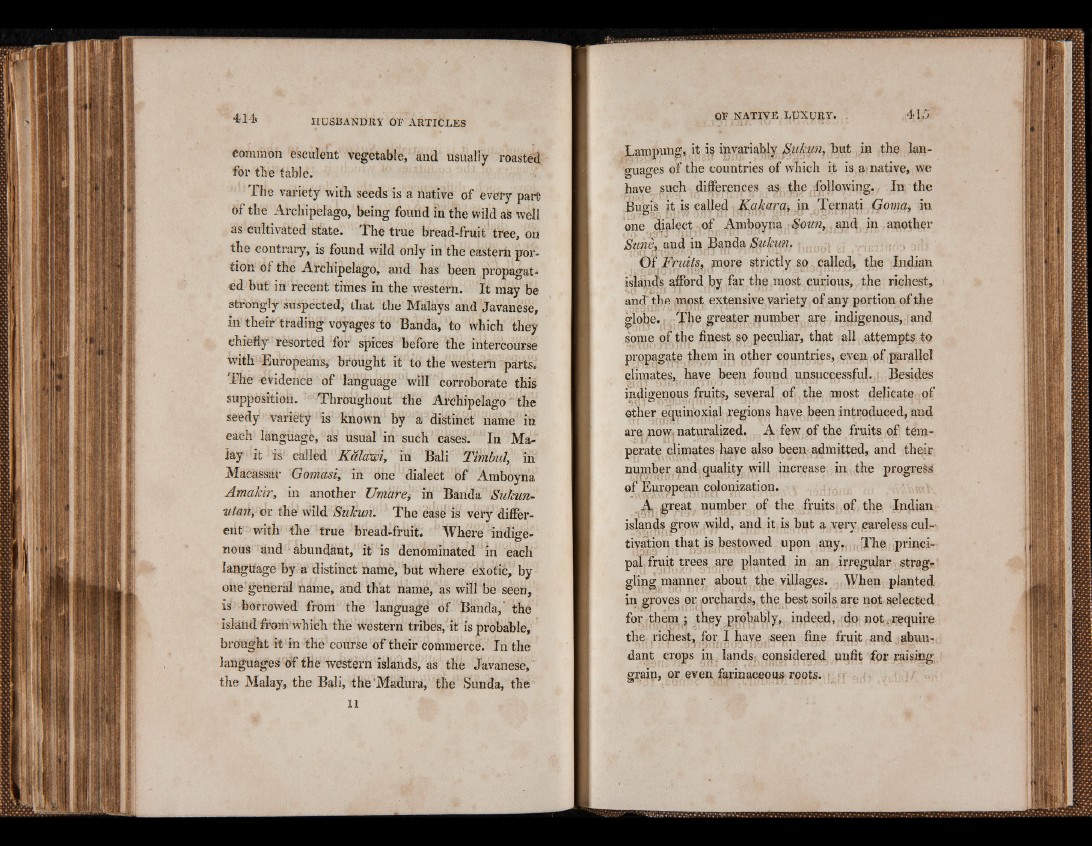
4 1 é H U SBA N D R Y OP ARTICLES
Common esculent vegetable, and usually roasted
for the table.
The variety with seeds is a native of every part
Of the Archipelago, being found in the wild afe well
as cultivated state. The true bread-fruit tree, on
the contrary, is found wild only in the eastern portion
of the Archipelago, and has been propagate
ed but in recent times in the western. It may be
strongly suspected, that the Malays and Javanese,
in their trading voyages to Banda, to which they
chiefly resorted for spices before the intercourse
with Europeans, brought it to the western parts.
The evidence of language will corroborate this
supposition. Throughout the Archipelago the
seedy variety is known by a distinct name in
each language, as usual in such cases. In Malay
it is called Kàlàwì, in Bali Timbiil, in
Macassar Gomasi, in one dialect of Amboyna
Amahir, in another Umare§ in Banda Sukun-
titan, or the wild Snfcun. The case is very different
with the true bread-fruit. Where indigenous
and abundant, it is denominated'in each
language by a distinct name, but where exotic, by
one general name, and that name, as will be seen,
is borrowed from the language O f Banda, the
island from which the western tribes, it is probable,
brought it in the course of their commerce. In the
languages of the western islands, as the Javanese,
the Malay, the Bali, the'Madura, the Sunda, the
11
OF N A T IV E L pX U R Y .
Lampung, it is invariably S;ukun, but in the lan-
«•uaffes of the countries to to of which it is a native, we
h a v e such differences as the following. In the
Bugis it is calleà Jfcafyara, in Ternati Qoma, in
one dialect of Amboyna Sonn, and in another
and in BandaSukim. ■ ,
Of Fruits, more strictly so called, the Indian
islands afford by far the most curious, the richest,
and' the most extensive variety of any portion of the
globe, r The greater numbep are indigenous, and
some of the finest so peculiar, that all attempts to
propagate them in other countries, even of parallel
climates, have been found unsuccessful. Besides
indigenous fruits, several o f, the most delicate of
other équinoxial regions have been introduced, and
are now. naturalized. A few of the fruits of temperate
climates have also been admitted, and their
number and quality will increase in the progress
of European colonization.
A great number of the fruits of the Indian
islands grow wild, and it is but a very careless cultivation
that is bestowed upon any. . The principal
fruit trees are planted in an irregular straggling
manner about the villages. When planted
in groves jfc orchards, the best soils are not selected
for them ; they probably, indeed, do not .require
the richest, for I have seen fine fruit and abundant
crops in lands : considered unfit for raising
grain, or even farinaceous roots. -